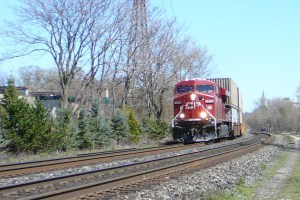The Irony of Time and Trains
I grew up in Cote St. Luc, a Montreal neighbourhood surrounded on three sides by train tracks. I remember swinging in a small park at the end of my street, counting the train cars and singing their labels to the

(click to enlarge)
rhythm of their clickety-clack.
(The first trains in England provoked anxiety due to their speed. Running at the unbelievable rate of 30 mph, they were thought to potentially damage the human body, which wasn’t built for that speed, obviously!)
The whistle of a train evokes something eerie, the ghosts of its travellers and legends of stopped time.
Trains always meant travel to me, more so than planes. I saved babysitting money for four years for a plane trip, but travelling by train was immediate and visible at ground level, easy escape to somewhere else. When I was fifteen, I went by train to Kenora where all the teens in my youth group met, travelling by train from the east and the west of Canada. Later, when I went to university, I saw my mother recede, small in the background, as I left home for good.
My parents had different associations with trains, more to do with cattle cars and concentration camps which they had experienced in their early teens. It only occurred to me as an adult how strange it was that this train-encircled area had developed postwar as a Jewish enclave. There must have been a lot of young parents sufficiently motivated by the affordable cost of housing to put up with being freaked out by the sound of trains.
And here I am, strangely, in love with trains and, being a writer of historical fiction, with time, which itself owes a debt to trains. Standardized time, on my mind as I lost an hour of sleep this weekend switching over to DST, was a consequence of train travel. Before the railroad, every town had its own time and its own clock. People travelled slower then, more individually by coach or cart or foot, and goods travelled by boat, their destinations limited by sea and river. But coordinating trains requires schedules, and Sir Sanford Fleming, a Canadian engineer proposed standardized time zones. In 1851, he designed the three penny beaver, Canada’s first postage stamp.
Now, I live a block from railroad tracks. Just far enough so that my house doesn’t shake (unless there’s an unusually heavy load), and close enough to hear the whistle. I still go to the end of my street to watch them. I’ve been known to wave to the conductor. They’ve been known to wave back.
Lilian Nattel's Blog
- Lilian Nattel's profile
- 133 followers



